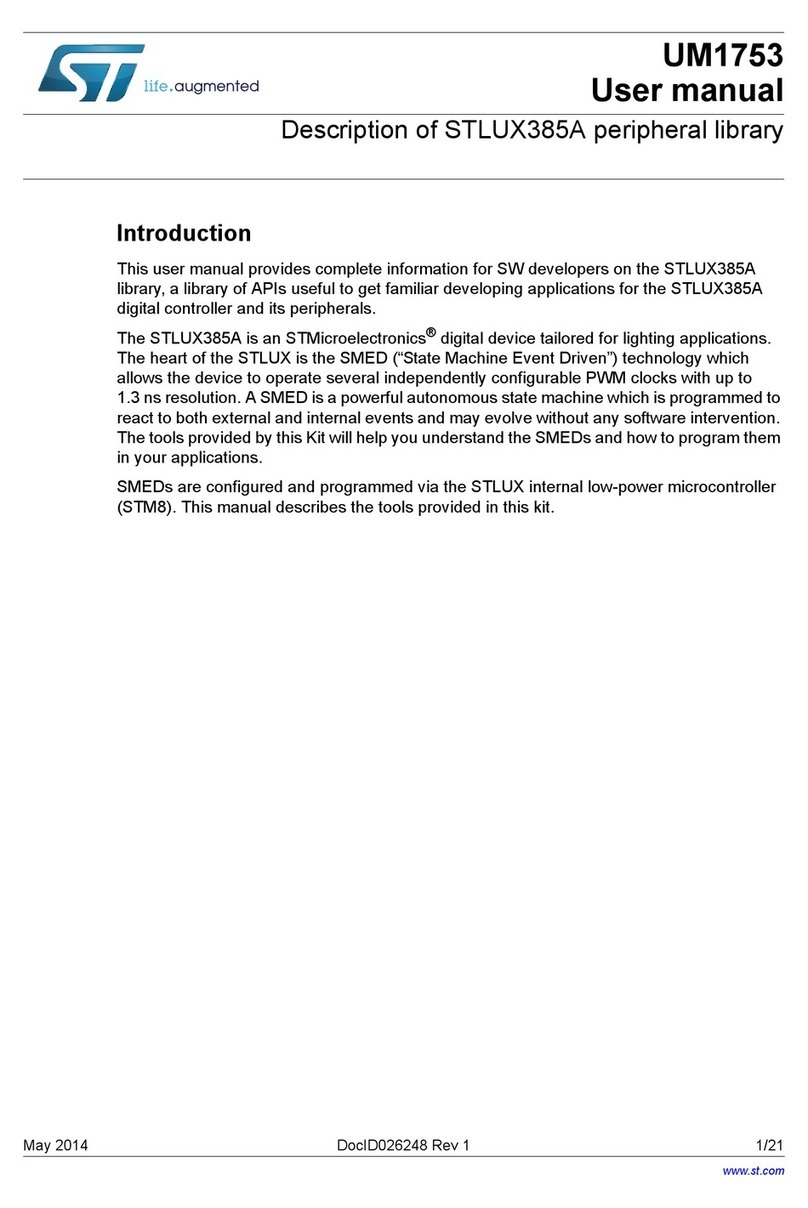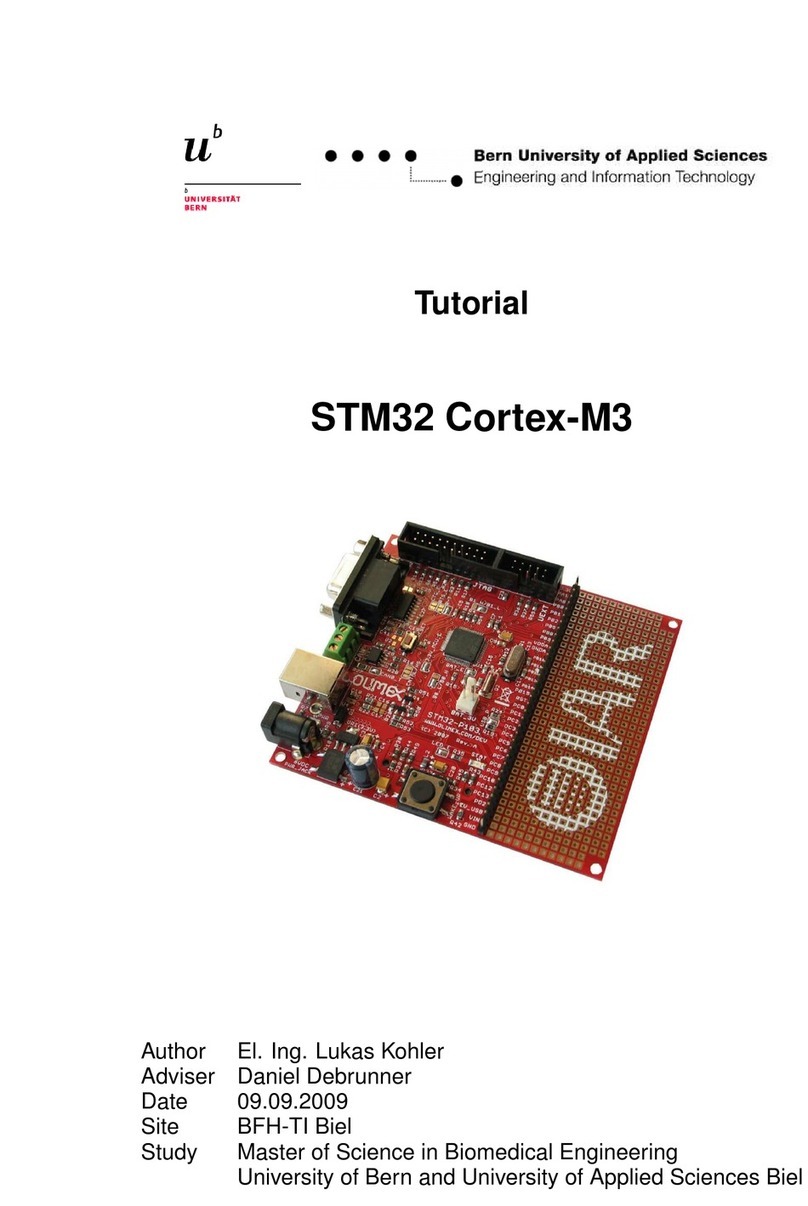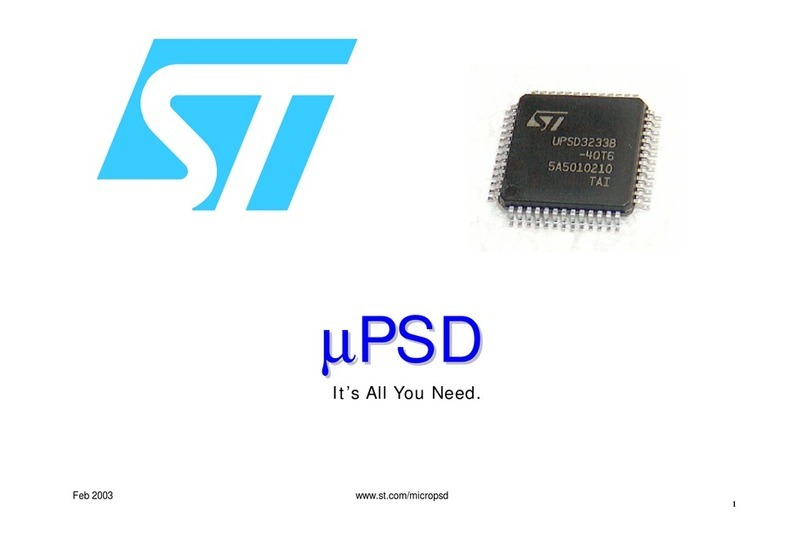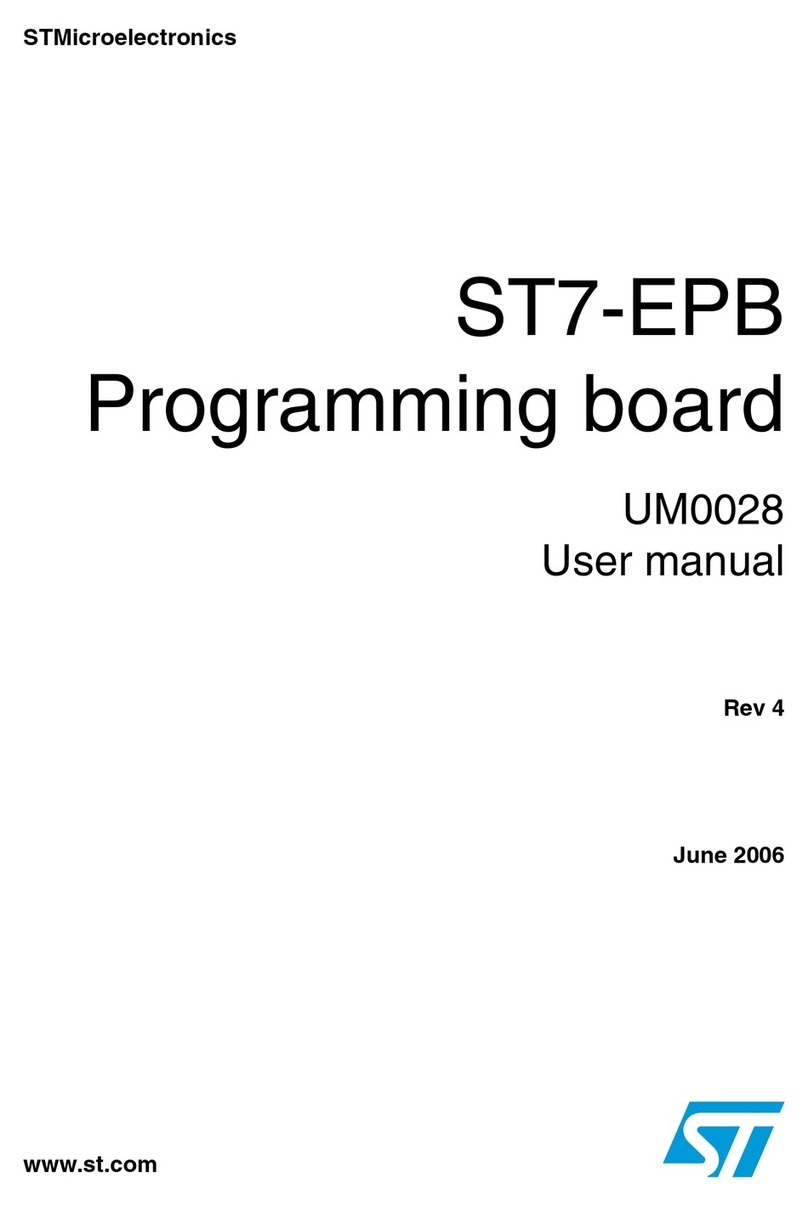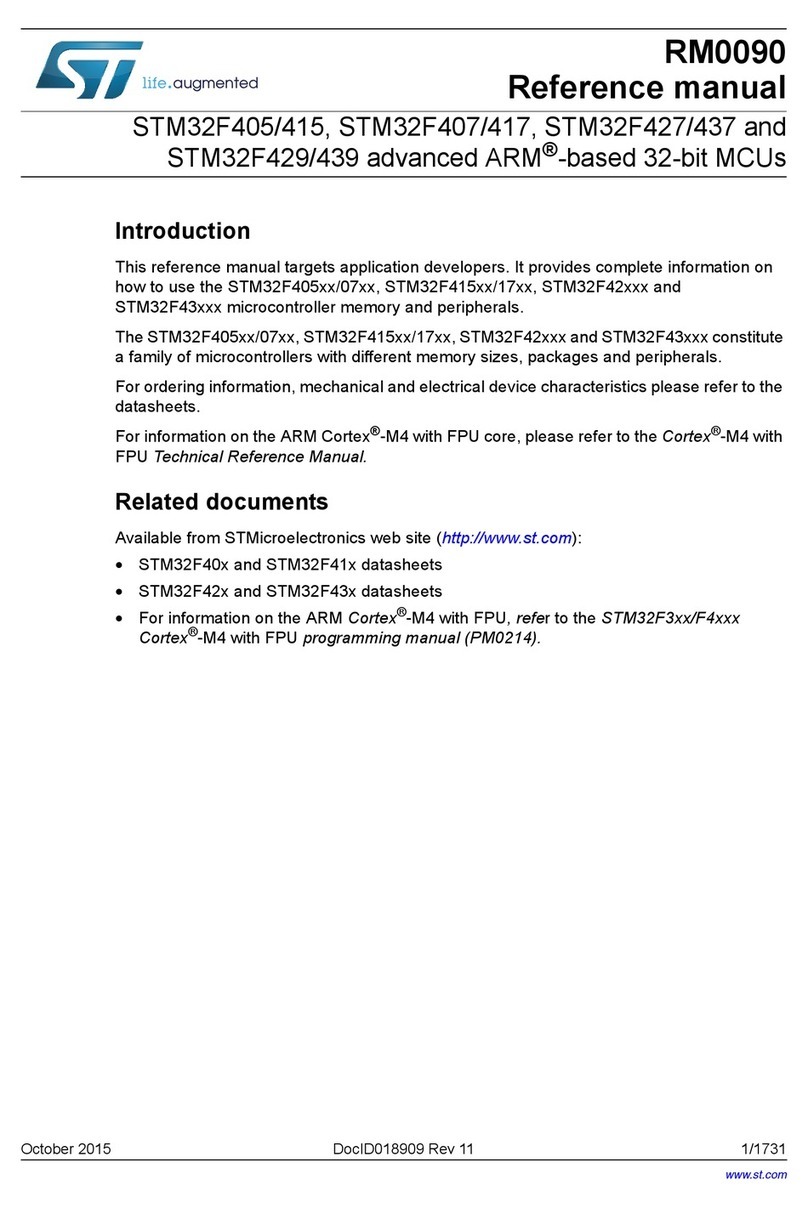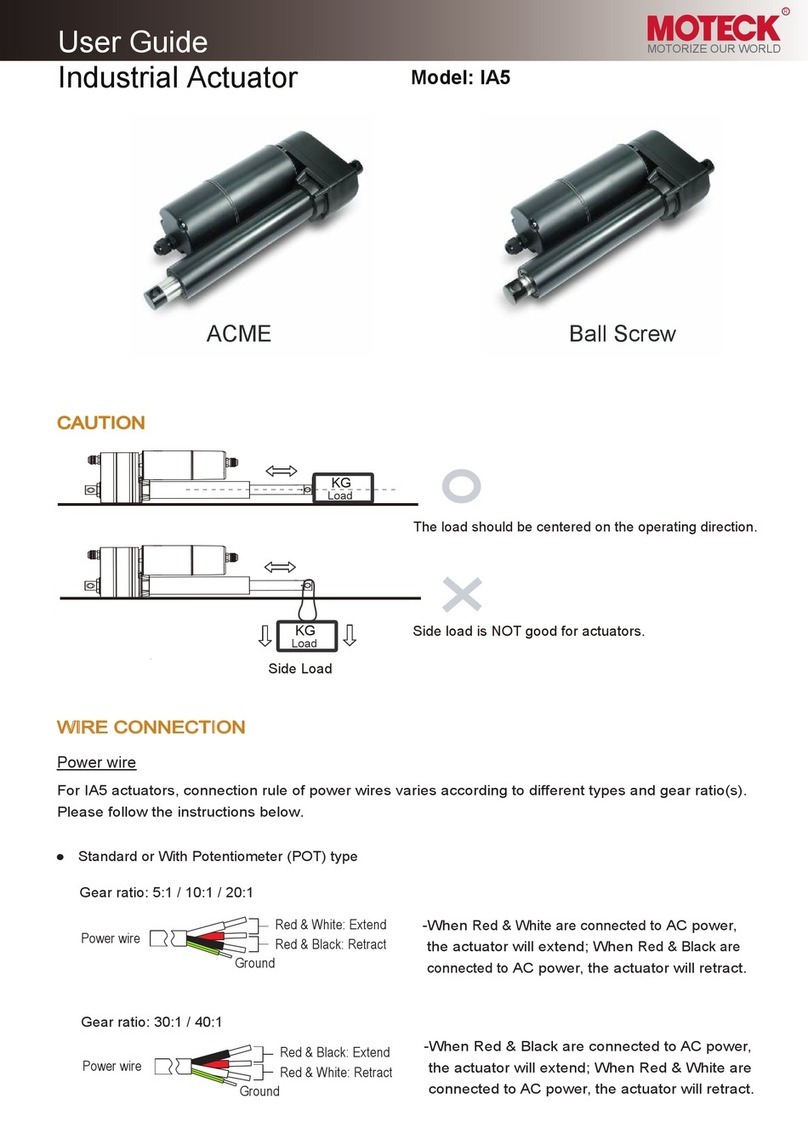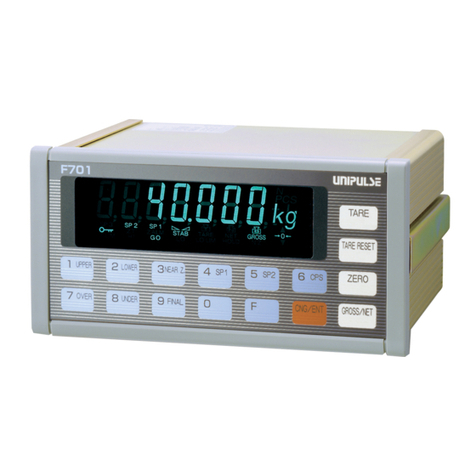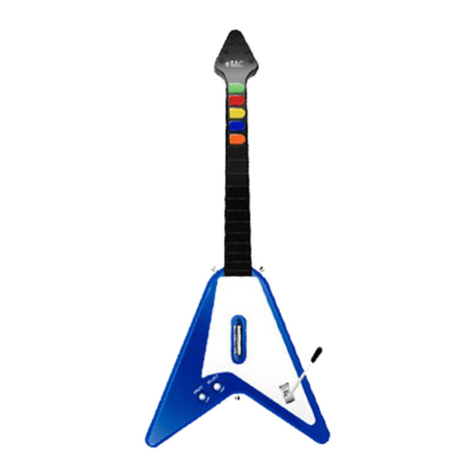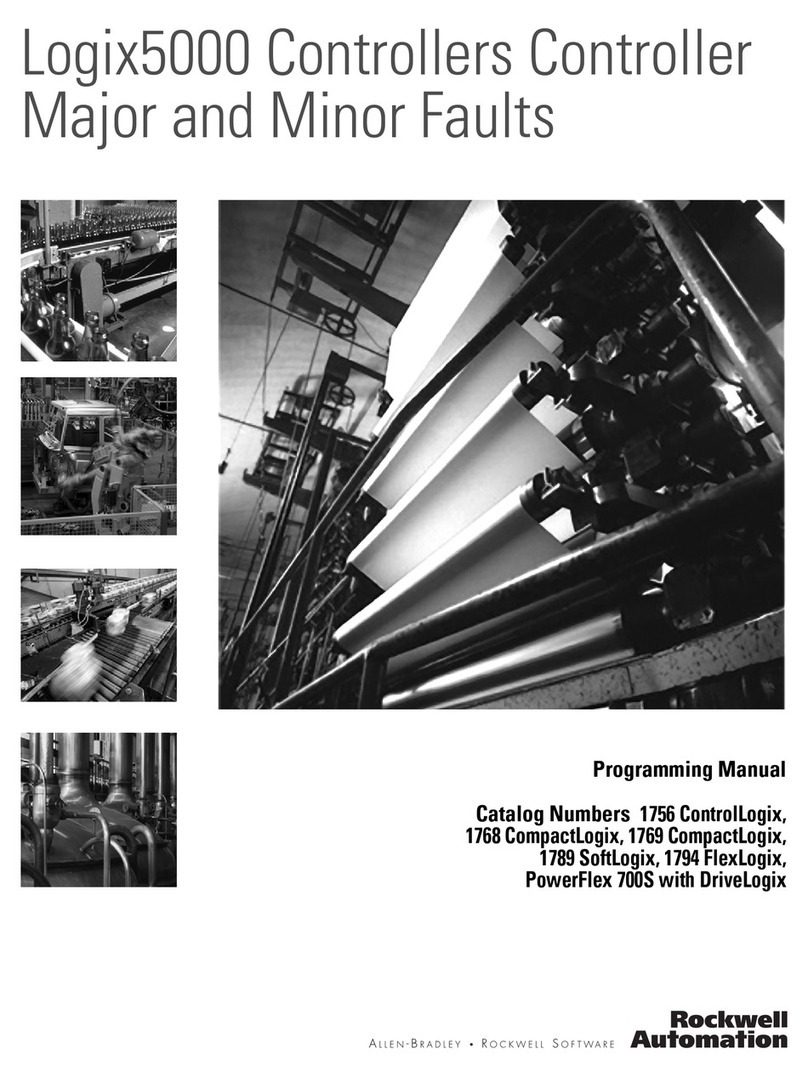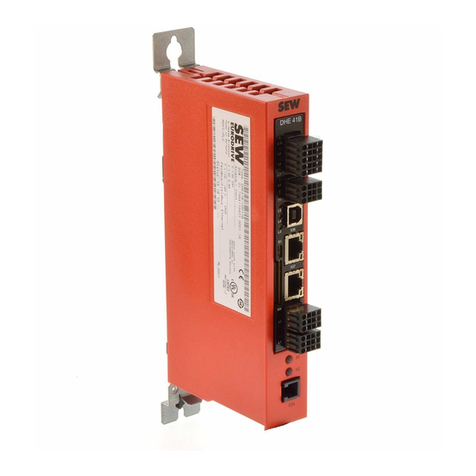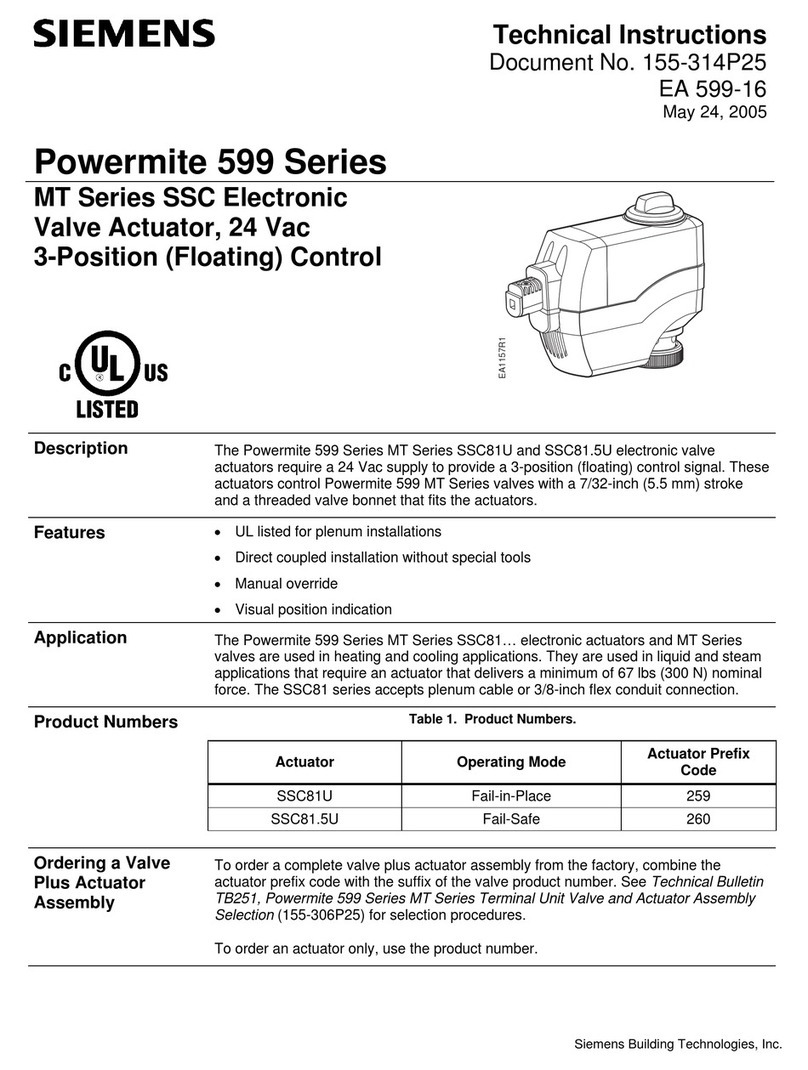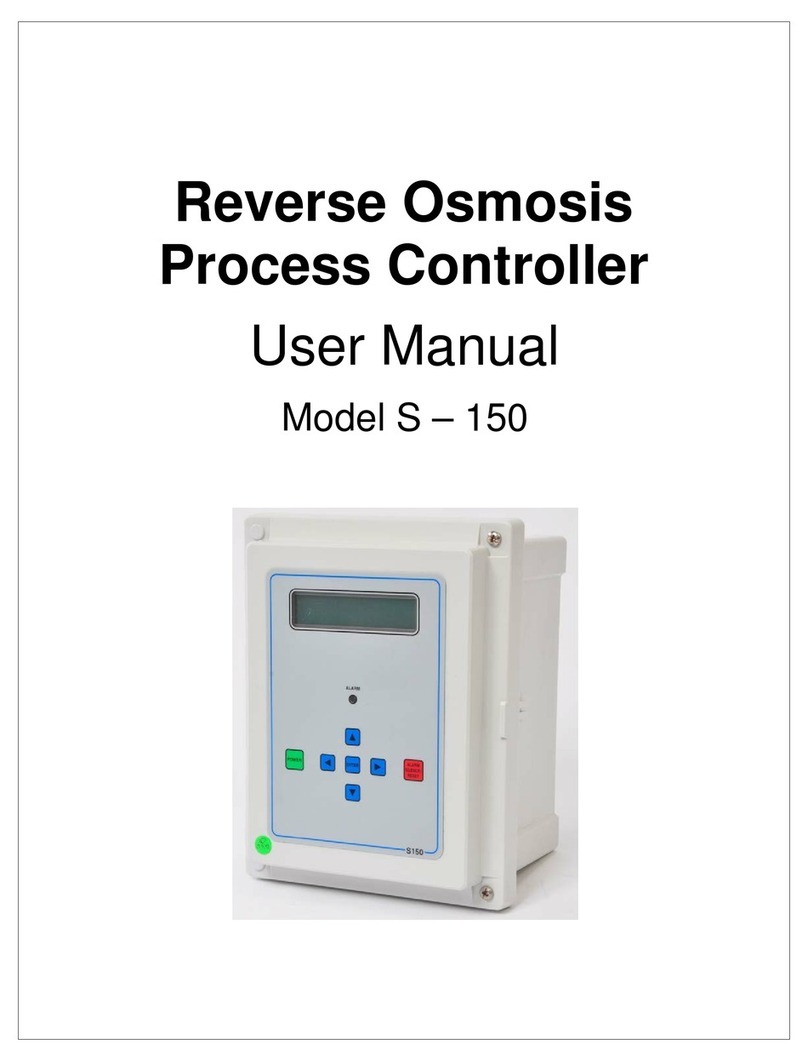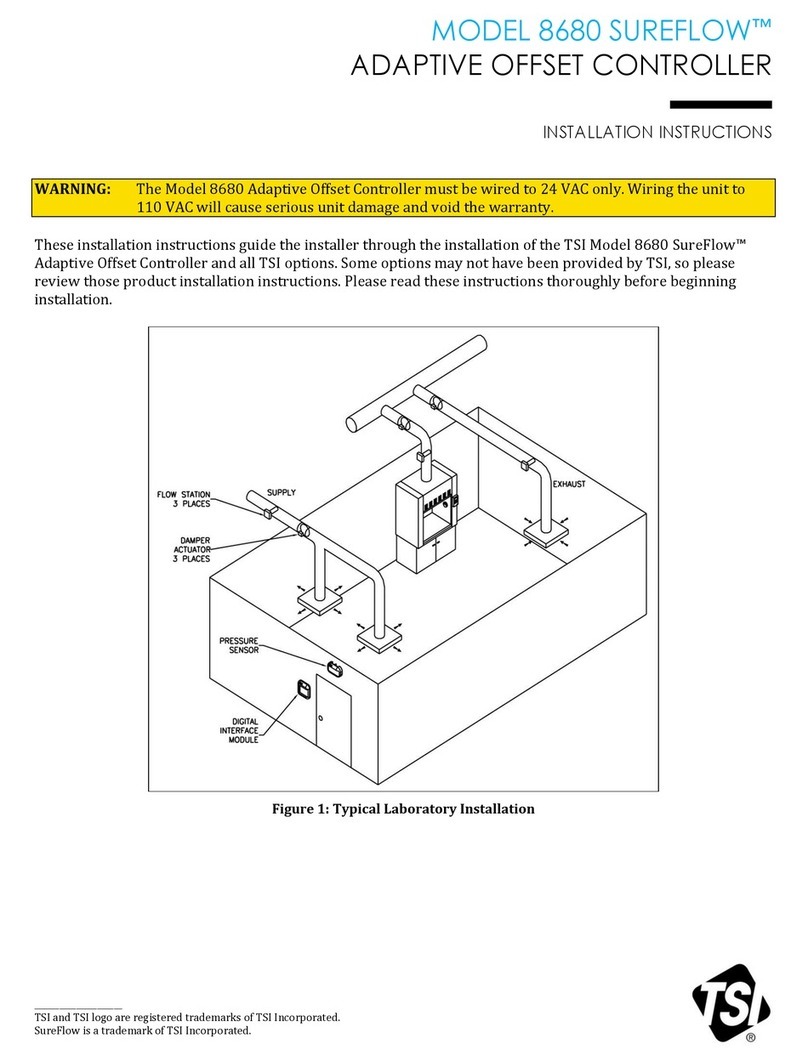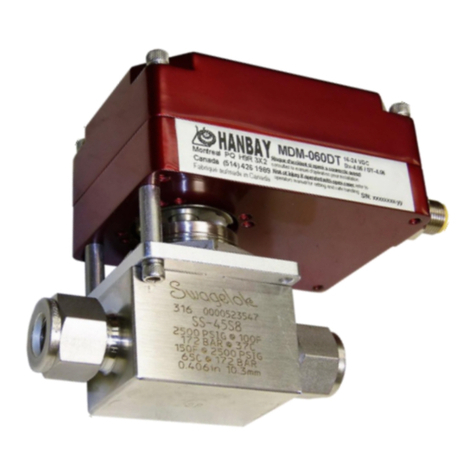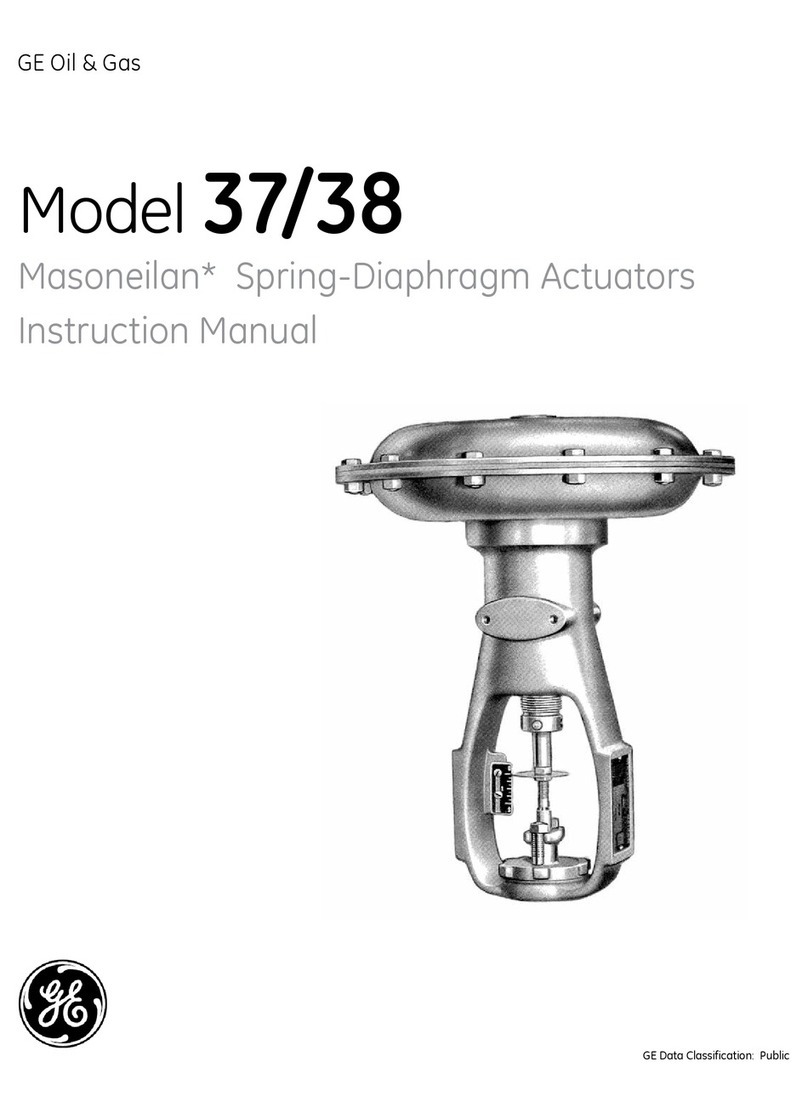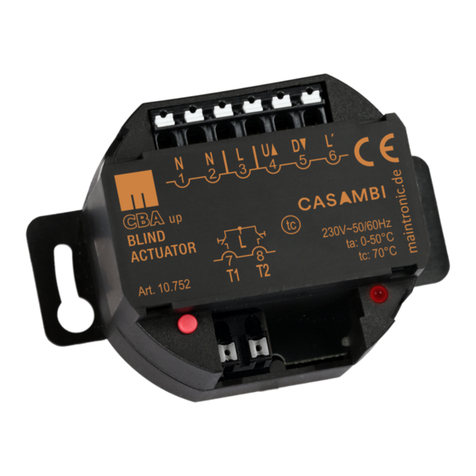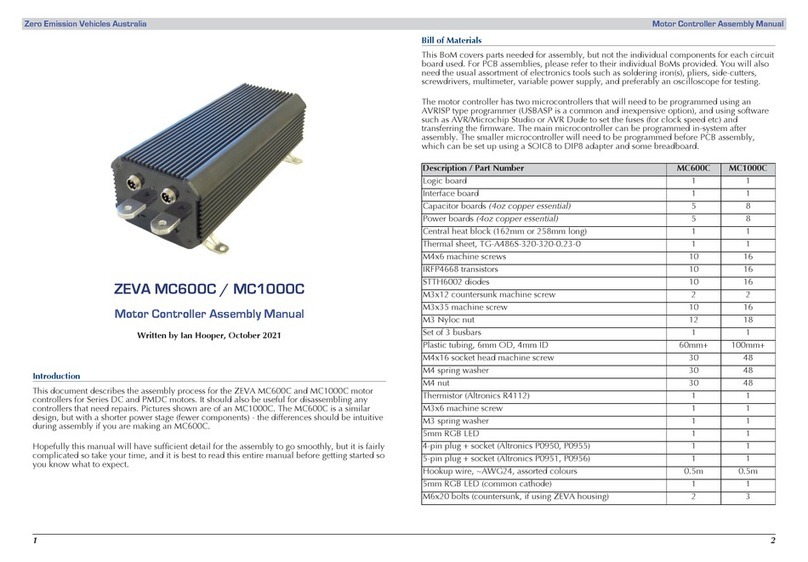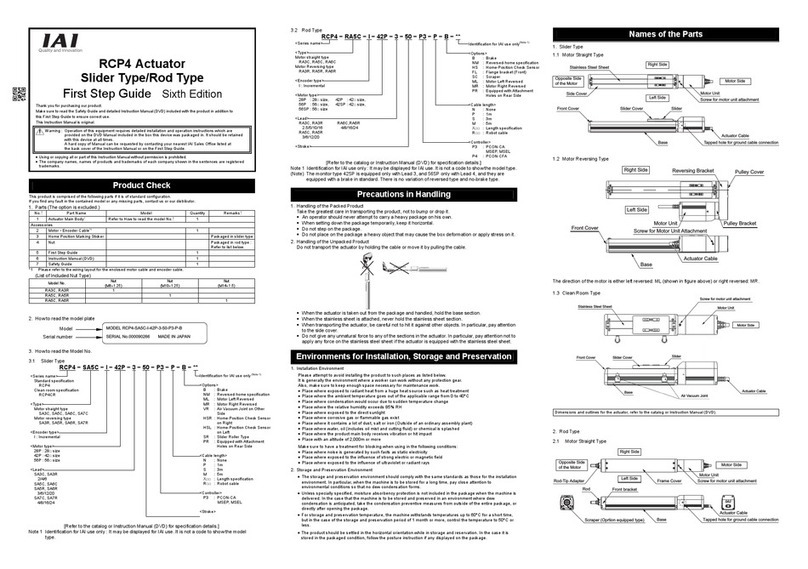STMicroelectronics B-G431B-ESC1 User manual

March 2021 UM2516 Rev 4 1/29
1
UM2516
User manual
Electronic speed controller Discovery kit for drones
with STM32G431CB
Introduction
The B-G431B-ESC1 Discovery kit is mainly based on the STM32G431CB microcontroller,
the L6387 driver, and STL180N6F7 power MOSFETs. Its breakable form includes an
electronic speed controller (ESC) board and a daughterboard for user interface with
embedded ST-LINK/V2-1. The ESC has a very compacted size with the goal to drive a
single 3-phase brushless motor (BLDC/PMSM), performing a sensorless field-oriented
control (FOC) or 6-step control with speed regulation and active braking function. This unit
can be connected with an external battery (LiPo type) and accepts a command signal from
an external unit, for instance, a flight control board or similar. The system provides different
communication buses (UART, CAN, PWM) for driving and monitoring, and also embeds an
overcurrent and thermal protection circuit. The daughterboard contains an ST-LINK in-circuit
debugger and programmer, allowing the user to program and debug the STM32G431CB
microcontroller directly with a USB cable using a compatible toolset. Its form factor is
suitable for small and very light R/C vehicles and their motor current capability, and also fits
big vehicle requirements, for instance, a prosumer drone.
.
Pictures are not contractual.
Figure 1. B-G431B-ESC1 Discovery kit
(front view)
Figure 2. B-G431B-ESC1 Discovery kit
(bottom view)
www.st.com

Contents UM2516
2/29 UM2516 Rev 4
Contents
1 Features . . . . . . . . . . . . . . . . . . . . . . . . . . . . . . . . . . . . . . . . . . . . . . . . . . . 6
2 Ordering information . . . . . . . . . . . . . . . . . . . . . . . . . . . . . . . . . . . . . . . . 7
2.1 Codification . . . . . . . . . . . . . . . . . . . . . . . . . . . . . . . . . . . . . . . . . . . . . . . . . 7
3 Development environment . . . . . . . . . . . . . . . . . . . . . . . . . . . . . . . . . . . . 8
3.1 System requirements . . . . . . . . . . . . . . . . . . . . . . . . . . . . . . . . . . . . . . . . . 8
3.2 Development toolchains . . . . . . . . . . . . . . . . . . . . . . . . . . . . . . . . . . . . . . . 8
3.3 Software tool . . . . . . . . . . . . . . . . . . . . . . . . . . . . . . . . . . . . . . . . . . . . . . . 8
4 Description . . . . . . . . . . . . . . . . . . . . . . . . . . . . . . . . . . . . . . . . . . . . . . . . . 9
5 Hardware layout and configuration . . . . . . . . . . . . . . . . . . . . . . . . . . . . 11
5.1 Block diagram . . . . . . . . . . . . . . . . . . . . . . . . . . . . . . . . . . . . . . . . . . . . . . .11
5.2 Board dimensions . . . . . . . . . . . . . . . . . . . . . . . . . . . . . . . . . . . . . . . . . . . 13
5.3 Communication, programming, and command interfaces . . . . . . . . . . . . 14
5.4 Motor sensor connection (Hall or encoder) . . . . . . . . . . . . . . . . . . . . . . . 15
5.5 CAN connection and configuration . . . . . . . . . . . . . . . . . . . . . . . . . . . . . . 15
5.6 STM32G431CB pinout for motor control . . . . . . . . . . . . . . . . . . . . . . . . . 16
6 Connection and first execution of the electronic speed controller (ESC)
program . . . . . . . . . . . . . . . . . . . . . . . . . . . . . . . . . . . . . . . . . . . . . . . . . . 19
6.1 First case: daughterboard not removed . . . . . . . . . . . . . . . . . . . . . . . . . . 19
6.2 Second case: daughterboard removed . . . . . . . . . . . . . . . . . . . . . . . . . . 21
7 B-G431B-ESC1 Discovery kit information . . . . . . . . . . . . . . . . . . . . . . 23
7.1 Product marking . . . . . . . . . . . . . . . . . . . . . . . . . . . . . . . . . . . . . . . . . . . . 23
7.2 B-G431B-ESC1 product history . . . . . . . . . . . . . . . . . . . . . . . . . . . . . . . . 24
7.2.1 Product identification BG431BESC1$AU1 . . . . . . . . . . . . . . . . . . . . . . 24
7.2.2 Product identification BG431BESC1$AU2 . . . . . . . . . . . . . . . . . . . . . . 24
7.2.3 Product identification BG431BESC1$AU3 . . . . . . . . . . . . . . . . . . . . . . 24
7.3 Board revision history . . . . . . . . . . . . . . . . . . . . . . . . . . . . . . . . . . . . . . . . 25

UM2516 Rev 4 3/29
UM2516 Contents
3
Appendix A Federal Communications Commission (FCC) and
ISED Canada Compliance Statements. . . . . . . . . . . . . . . . . . . . . . . 26
A.1 FCC Compliance Statement . . . . . . . . . . . . . . . . . . . . . . . . . . . . . . . . . . . 26
A.2 ISED Compliance Statement. . . . . . . . . . . . . . . . . . . . . . . . . . . . . . . . . . . 27
Revision history . . . . . . . . . . . . . . . . . . . . . . . . . . . . . . . . . . . . . . . . . . . . . . . . . . . . 28

List of tables UM2516
4/29 UM2516 Rev 4
List of tables
Table 1. Ordering information . . . . . . . . . . . . . . . . . . . . . . . . . . . . . . . . . . . . . . . . . . . . . . . . . . . . . . . 7
Table 2. Codification explanation . . . . . . . . . . . . . . . . . . . . . . . . . . . . . . . . . . . . . . . . . . . . . . . . . . . . 7
Table 3. Truth table. . . . . . . . . . . . . . . . . . . . . . . . . . . . . . . . . . . . . . . . . . . . . . . . . . . . . . . . . . . . . . 16
Table 4. Main board STM32G431CB pinout for motor control . . . . . . . . . . . . . . . . . . . . . . . . . . . . . 16
Table 5. Input/output terminal table . . . . . . . . . . . . . . . . . . . . . . . . . . . . . . . . . . . . . . . . . . . . . . . . . 18
Table 6. SWD connector for MCU programming (daughterboard removed) . . . . . . . . . . . . . . . . . . 21
Table 7. Document revision history . . . . . . . . . . . . . . . . . . . . . . . . . . . . . . . . . . . . . . . . . . . . . . . . . 28

UM2516 Rev 4 5/29
UM2516 List of figures
5
List of figures
Figure 1. B-G431B-ESC1 Discovery kit (front view) . . . . . . . . . . . . . . . . . . . . . . . . . . . . . . . . . . . . . . 1
Figure 2. B-G431B-ESC1 Discovery kit (bottom view). . . . . . . . . . . . . . . . . . . . . . . . . . . . . . . . . . . . . 1
Figure 3. Target application . . . . . . . . . . . . . . . . . . . . . . . . . . . . . . . . . . . . . . . . . . . . . . . . . . . . . . . . . 6
Figure 4. System structure overview . . . . . . . . . . . . . . . . . . . . . . . . . . . . . . . . . . . . . . . . . . . . . . . . . 10
Figure 5. Block diagram with ST products . . . . . . . . . . . . . . . . . . . . . . . . . . . . . . . . . . . . . . . . . . . . . 11
Figure 6. B-G431B-ESC1 top view . . . . . . . . . . . . . . . . . . . . . . . . . . . . . . . . . . . . . . . . . . . . . . . . . . 11
Figure 7. B-G431B-ESC1 bottom view . . . . . . . . . . . . . . . . . . . . . . . . . . . . . . . . . . . . . . . . . . . . . . . 12
Figure 8. B-G431B-ESC1 board mechanical dimensions (top view) . . . . . . . . . . . . . . . . . . . . . . . . . 13
Figure 9. Communication, programming, and command interfaces . . . . . . . . . . . . . . . . . . . . . . . . . 14
Figure 10. Motor sensor connection . . . . . . . . . . . . . . . . . . . . . . . . . . . . . . . . . . . . . . . . . . . . . . . . . . 15
Figure 11. ESC connections with CAN communication . . . . . . . . . . . . . . . . . . . . . . . . . . . . . . . . . . . . 16
Figure 12. B-G431B-ESC1 connection for MCU programming . . . . . . . . . . . . . . . . . . . . . . . . . . . . . . 19
Figure 13. ST MC Workbench screen . . . . . . . . . . . . . . . . . . . . . . . . . . . . . . . . . . . . . . . . . . . . . . . . . 20
Figure 14. B-G431B-ESC1 I/O connection . . . . . . . . . . . . . . . . . . . . . . . . . . . . . . . . . . . . . . . . . . . . . 20
Figure 15. PWM input signal for motor speed regulation. . . . . . . . . . . . . . . . . . . . . . . . . . . . . . . . . . . 21
Figure 16. SWD configuration on IAR tool . . . . . . . . . . . . . . . . . . . . . . . . . . . . . . . . . . . . . . . . . . . . . . 22

Features UM2516
6/29 UM2516 Rev 4
1 Features
•Full reference design for electronic speed controller capable of both sensorless FOC
and 6-step algorithm
•Designed for drones with up to 6S LiPo battery pack or equivalent suitable DC supply
•3-phase driver board for BLDC/PMSM motors with discrete N-channel 60 V, 120 A
STripFET F7 power MOSFETs
•Arm®(a) Cortex®-M4 32-bit STM32G431CB MCU, 213 DMIPS, 128 Kbytes of Flash
memory, 32 Kbytes of SRAM, analog rich, math accelerator
•On-board ST-LINK/V2-1 debugger /programmer detachable from the main board
•Output peak motor current (maximum peak current tested with a propeller to have an
air-forced cooling): 40 A
•Designed with SMD ceramic capacitors with very low profiles
•BEC available through the daughterboard (5 V for external board supplying, for
example a flight control board)
•Support for motor sensors (Hall or encoder)
•Supported by ST motor control software development kit (SDK) with ST motor profiler
•3-shunt mode supported for motor current sensing
•L6387 High voltage high and low-side driver with integrated interlocking function
•Overcurrent and overvoltage protection feature (OCP/OVP)
•Thermal measuring and overheating protection with NTC on board
•ESC ready for communication with any standard flight control unit (FCU):
PWM/CAN/UART
•Potentiometer and user button available on the daughterboard
•2 user LEDs: 1 green LED for 3.3 V level, and 1 red LED configurable by the user
•Target applications: motor driving for R/C vehicles, UAV drone, electric car, or boat
•PCB type and size:
– FR-4 PCB material
– 8-layer layout
– Dimensions (including the daughterboard with ST-LINK part): 30 mm x 41 mm
– Weight (including the daughterboard with ST-LINK part): 9.2 g
•RoHS compliant
Figure 3. Target application
a. Arm is a registered trademark of Arm Limited (or its subsidiaries) in the US and/or elsewhere.

UM2516 Rev 4 7/29
UM2516 Ordering information
28
2 Ordering information
To order the B-G431B-ESC1 Discovery kit, refer to Table 1. Additional information is
available from the datasheet and reference manual of the target STM32.
2.1 Codification
The meaning of the codification of the Discovery kit is explained in Table 2.
Table 1. Ordering information
Order code Board reference Target STM32
B-G431B-ESC1 MB1419 STM32G431CBU6
Table 2. Codification explanation
B-XXYYZ-ESCN Description Example: B-G431B-ESC1
XX MCU series in STM32 32-bit
Arm Cortex MCUs STM32G4 Series
YY MCU product line in the series STM32G431
ZSTM32 Flash memory size:
– B for 128 Kbytes 128 Kbytes
ESCN Electronic speed controller
version number ESC1

Development environment UM2516
8/29 UM2516 Rev 4
3 Development environment
3.1 System requirements
•Windows®OS (7, 8 and 10), Linux®64-bit, or macOS®(a)(b)
•USB Type-A or USB Type-C®to Micro-B cable
3.2 Development toolchains
•IAR Systems®- IAR Embedded Workbench®(c)
•Keil®- MDK-ARM(c)
•STMicroelectronics - STM32CubeIDE
3.3 Software tool
This board is supported by the X-CUBE-MCSDK STM32Cube Expansion Package
dedicated for motor-control applications. The source code is available and it is included and
generated with this tool. The B-G431B-ESC1 does not have a demonstration firmware
preloaded in the STM32 Flash memory, so for the first usage, the user must connect it with
the X-CUBE-MCSDK tool.
a. macOS®is a trademark of Apple Inc. registered in the U.S. and other countries.
b. All other trademarks are the property of their respective owners.
c. On Windows®only.

UM2516 Rev 4 9/29
UM2516 Description
28
4 Description
The B-G431B-ESC1 Discovery kit is an electronic speed controller (ESC) that drives a
single 3-phase brushless motor with very high-performance control. It is commonly used
inside the R/C field, for instance, drones, electric cars, and boats, to provide fast and
efficient propulsion for the movement. This unit must be capable of low- and very high-
speed regulation and strong dynamic response to different load conditions. An external
signal, through a communication bus between the ESC board and a generic central unit,
sets the reference value for the speed regulation, and another signal sends the status of the
system. For instance, if a fault occurs, a central unit can decide to enable an emergency
procedure.
In the mass market, a lot of ESCs are available to cover different kinds of R/C models, from
the toy up to the professional unit, with different motor current capabilities, different sizes,
and input voltage requirements. All of these boards are based on the same control
algorithm, 6-step or trapezoidal, with no shunt resistors in a lot of cases.
B-G431B-ESC1 performs otherwise more sophisticated and smart control algorithm based
on Field Oriented Control (FOC) comparing with the 6-step algorithm, in particular, it offers
the following features:
•Better torque control
•Motor current regulation in case of a fast load change
•Vibration reduction
•Active braking function
•Better efficiency
•Noise reduction
•A real-time monitor of the rotor speed
•Energy recovery during the deceleration
The Discovery kit is also compatible with the 6-step control with embedded Bemf hardware
circuit for rotor position estimation.

Description UM2516
10/29 UM2516 Rev 4
The typical system architecture is shown in Figure 4.
Each ESC board is connected with a single brushless motor, in this case, a quadcopter
system is taken as an example. An external LiPo battery provides the right power to the four
connected boards and through a wired bus, each ESC board receives or sends commands
from or to an external unit, for instance, a flight control unit.
Figure 4. System structure overview
The B-G431B-ESC1 provides the maximum flexibility in term of communication protocol
(UART, PWM, and CAN are available on-board), and it also contains a DC-DC converter on
the daughterboard, with 5 V output connector (BEC) to supply an external board, for
instance, a flight control unit or sensors.

UM2516 Rev 4 11/29
UM2516 Hardware layout and configuration
28
5 Hardware layout and configuration
5.1 Block diagram
The B-G431B-ESC1 Discovery kit is a complete hardware platform (power and control)
based on several ST products as shown in the following block diagram:
Figure 5. Block diagram with ST products
The top side is mainly dedicated to the power section. It is composed of power MOSFETs,
gate drivers, and a DC-DC converter.
Figure 6. B-G431B-ESC1 top view

Hardware layout and configuration UM2516
12/29 UM2516 Rev 4
The bottom side is mainly dedicated to the digital section. It is composed of the
STM32G431CB microcontroller that performs a three shunt both sensorless and sensored
FOC control and 6-step control in an LQFP 48pin package.
The STM32G431CB devices are based on the high-performance Arm®Cortex®-M4 32-bit
RISC core. They operate at a frequency of up to 170 MHz. The Cortex-M4 core features a
single-precision floating-point unit (FPU), which supports all the Arm®single-precision data-
processing instructions and all the data types. It also implements a full set of DSP (digital
signal processing) instructions and a memory protection unit (MPU) which enhances the
application's security.
The devices embed peripherals allowing mathematical/arithmetic function acceleration
(CORDIC co-processor for trigonometric functions and FMAC unit for Filter Functions).
They offer two fast 12-bit ADCs (5 Msps), four comparators, three operational amplifiers,
four DAC channels (2 external and 2 internal), an internal voltage reference buffer, a low-
power RTC, one general-purpose 32-bit timers, two 16-bit PWM timers dedicated to motor
control, seven general-purpose 16-bit timers, and one 16-bit low-power timer.
Figure 7. B-G431B-ESC1 bottom view

Hardware layout and configuration UM2516
14/29 UM2516 Rev 4
5.3 Communication, programming, and command interfaces
The B-G431B-ESC1 Discovery kit is equipped with a USB connector and different pads for
communication, such as:
•U4 USB port for programming and debugging
•J1 for CAN port
•J2 for SWD-STM32F103 (reserved)
•J3 for PWM/UART/BECout input/output signal
•J4 for SWD-STM32G431 debug/programming port (without daughterboard)
•J8 for motor sensor (Hall or encoder)
Figure 9. Communication, programming, and command interfaces
The USB interface is provided on the daughterboard and it allows to program and debug the
main board. It provides also the supply voltage to the STM32G431CB MCU in case of no
voltage on the bus (J5 and J6 not connected to the LiPo battery). The USB port is available
to use the ST MC Workbench and Motor Profiler tool directly connected with the PC (no
external dongle is needed).
The CAN interface is provided with an onboard transceiver and a termination resistor is
provided and manageable by firmware. The J1 connector has also 5V and GND pins (see
Section 5.5 for further info)
The J2 is reserved to program the MCU on the daughterboard.
The J3 pads are available on the top side of the main board. They provide the UART TX and
RX (for telemetry and firmware update respectively), the input PWM channel for motor
speed regulation. In particular, the PWM input signal (5 V tolerant) sets the motor speed
according to the Ton duration, for instance, 1060 µs for the minimal speed and 1860 µs for
the maximum speed. Other pins are for GND and 5 V. It is a power line to supply an external
board, for example, a flight control unit or equivalent. This voltage line is available only if the
daughterboard is not removed.

UM2516 Rev 4 15/29
UM2516 Hardware layout and configuration
28
The J4 solder pads provide the SWD connection between the STM32G431CB and the
external ST-LINK programmer if the daughterboard is removed. In this case, other pins are
available, such as 3V3 and GND.
The J8 solder pads allow the connection of the motor sensor, Hall, or encoder. Refer to
Section 5.4 for further information.
5.4 Motor sensor connection (Hall or encoder)
The Discovery kit embeds the hardware circuit for Hall or encoder sensor. A supply voltage
line is provided with 5 V and GND lines in J8 solder pads. This voltage is available also if the
daughterboard is removed. The ST MC workbench must be configured to use these sensors
during the FOC control.
Figure 10. Motor sensor connection
5.5 CAN connection and configuration
The main board includes the transceiver and the connection pads to use the CAN peripheral
available in the STM32G431CB MCU. The hardware circuit is based on UAVCAN standard
(https://uavcan.org/) so a little fuse is included to protect by overcurrent so that an
accidental short circuit on the device does not bring down the power on the entire bus. One
CAN output (J1) is provided on-board and T-connectors are needed to create the bus line
with several boards.
This circuit accepts also the supply voltage from the external unit, for example, a flight
control unit with a power CAN (5.0 V to 5.5 V on the bus power line). In this case, J1 solder
pads contain the 5V line (input) and if a voltage is applied to it, the main board generates the
3.3 V for G4MCU and the transceiver. This feature allows keeping the communication also
when the battery is discharged or removed. Figure 11 shows that two terminator resistors
are needed to open and close the CAN bus line. B-G431B-ESC1 includes this terminator
resistor (120 Ω) and it is manageable by firmware (CAN_TERM pin) with a low voltage
single-pole-double-throw analog onboard switch (see the CAN page on the electrical
schematic). Table 3 shows the logic to add or remove this resistor.

Hardware layout and configuration UM2516
16/29 UM2516 Rev 4
Figure 11. ESC connections with CAN communication
5.6 STM32G431CB pinout for motor control
Table 3. Truth table
CAN_TERM pin 120 Ωresistor
HON
LOFF
(1)
1. High impedance
Table 4. Main board STM32G431CB pinout for motor control
Pin Default Signal Solder Bridge
1VBAT 3V3 -
2 PC13/TAMP/RTC TIM1_CH1N -
3 PC14 CAN_TERM R26
4PC15 N.C. -
5 PF0/OSC-IN OSC 8Mhz -
6 PF1/OSC-OUT OSC 8Mhz R27
7 PG10/NRST RESET -
8 PA0 VBUS -
9 PA1 Curr_fdbk1_OPAmp+ -
10 PA2 OP1_OUT -
11 PA3 Curr_fdbk1_OPAmp- -
12 PA4 BEMF1 -
13 PA5 Curr_fdbk2_OPAmp- -
14 PA6 OP2_OUT -

UM2516 Rev 4 17/29
UM2516 Hardware layout and configuration
28
15 PA7 Curr_fdbk2_OPAmp+ -
16 PC4 BEMF2 -
17 PB0 Curr_fdbk3_OPAmp+ -
18 PB1 TP3 -
19 PB2 Curr_fdbk3_OPAmp- -
20 VREF+ 3v3 -
21 VDDA 3v3 -
22 PB10 N.C. -
23 VDD4 3V3 -
24 PB11 BEMF3 -
25 PB12 POTENTIOMETER -
26 PB13 N.C. -
27 PB14 Temperature feedback -
28 PB15 TIM1_CH3N -
29 PC6 STATUS -
30 PA8 TIM1_CH1 -
31 PA9 TIM1_CH2 -
32 PA10 TIM1_CH3 -
33 PA11 CAN_RX -
34 PA12 TIM1_CH2N -
35 VDD6 3V3 -
36 PA13 SWDIO -
37 PA14 SWCLK -
38 PA15 PWM -
39 PC10 BUTTON -
40 PC11 CAN_SHDN,TP2 -
41 PB3 USART2_TX -
42 PB4 USART2_RX -
43 PB5 GPIO_BEMF -
44 PB6 A+/H1 -
45 PB7 B+/H2 -
46 PB8 Z+/H3 -
47 PB9 CAN_TX -
48 VDD8 3V3 -
Table 4. Main board STM32G431CB pinout for motor control (continued)
Pin Default Signal Solder Bridge

UM2516 Rev 4 19/29
UM2516 Connection and first execution of the electronic speed controller (ESC) program
28
6 Connection and first execution of the electronic
speed controller (ESC)
program
For the correct usage and the first run of the B-G431B-ESC1 Discovery kit, the procedure
explained in Section 6.1 or Section 6.2 is suggested.
The ESC board is usually powered with a battery (on J5 and J6 input connectors). It can be
supplied with a laboratory power supply during software development. In this case, it is
recommended to disconnect the power supply wires when the supply is switched-off while
USB is connected (Some power supply types may cause board overheating in this case).
6.1 First case: daughterboard not removed
1. Connect a micro USB cable to the USB port on the daughterboard as shown in
Figure 12, and verify if the green led (D5) is turned on in the main board.
Figure 12. B-G431B-ESC1 connection for MCU programming
2. Connect the other part of the cable to the PC port and run the ST MC Workbench tool
for motor and parameter configuration (see Figure 13).
3. Generate and upload the firmware code into the STM32G431CB MCU with the
available IDE tool.

Connection and first execution of the electronic speed controller (ESC) program UM2516
20/29 UM2516 Rev 4
Figure 13. ST MC Workbench screen
4. Solder the three motor wires U, V, W at the motor (J7) solder pad with no particular
color sequence (see Figure 14)
5. Solder the PWM input and GND at J3 connector (pin 4 and pin 5). The PWM input
signal is either 3.3 V or 5 V (the PWM is connected to a 5 V tolerant MCU input pin).
6. Connect the main board with a LiPo battery (or DC power supply: min 3S - max 6S)
with the right polarity and turn ON. The input connector is composed of two large pads
for soldering. The Transil device prevents damage in case of reverse polarity at the
input side for a low time.
Figure 14. B-G431B-ESC1 I/O connection
Table of contents
Other STMicroelectronics Controllers manuals


